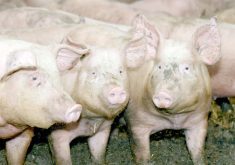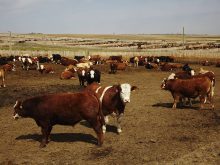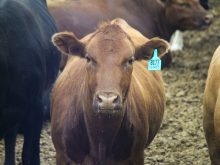CALGARY – Three million German pigs in Nurtinger housing are living the good life, says a German university hog researcher.
Gerhard Schwarting of the University of Nuertingen in southwestern Germany said disease problems, low growth rates and inefficiencies forced the German hog industry into an overhaul 10 years ago.
With help from researchers like Schwarting, producers decided changes had to start in the barns which were generally not healthy for pigs or the barn workers.
Further changes were forced by pressures from Europe’s powerful animal welfare movement that insisted governments step in and legislate reform.
Read Also

Lending policy still focused on primary producers: Farm Credit Canada
Farm Credit Canada said it has not changed its business practices and remains committed to supporting all producers, after a report from an Ottawa-based media outlet claimed otherwise.
Tougher regulations
The concessions and stricter regulations on animal care are a growing trend throughout Europe. In Germany, regulations state pigs must be given more exercise, fresh air and natural light. Slatted floors and sow crates to rear young piglets are not allowed.
“I don’t know why I need a law. This is common sense,” Schwarting told a North American agricultural finance conference held here recently.
The Nurtinger system, developed at the University of Nuertingen, grew out of these pressures for change. The system works well in Germany, Schwarting told those at the conference, because German hog farms range from 50 to 200 sow operations. The country doesn’t have room for large hog operations like those common in North America.
As well, German hog farmers are more specialized. One farm might handle breeding and farrowing, others raise weanlings while another finishes hogs for the market.
Schwarting said the changes have created a pleasant environment for the hogs. They need fewer drugs because they’re in better health and the public image of the industry has improved.
Hog heaven?
The Nurtinger system allows hogs freedom to move around, and temperature in each room is individually controlled. There are areas for pigs to hide from more aggressive pen mates and open walls provide natural ventilation. The barns are lit with natural daylight. They have solid floors in drinking and activity areas, and slatted floors in a shower and dunging room.
The dunging room provides privacy for each pig and is walled off from other areas of the pen.
Drinking water is warmed to improve feed intake and conversion because they drink more.
Another innovation is pig beds. Each pig is given a box made of rigid polyurethane with entrances covered by split plastic curtains. Warm air is circulated by a fan/heater unit. The pig’s body is kept warm and it can stick its head out for cooler air as it sleeps.
Bed size varies from the piglet to finisher hog stage. In the first days of the piglet’s life the bed can be heated to 42 C and lowered as the pigs grow.
A finisher pig can warm its own bed with body heat to about 25 to 28 degrees.















